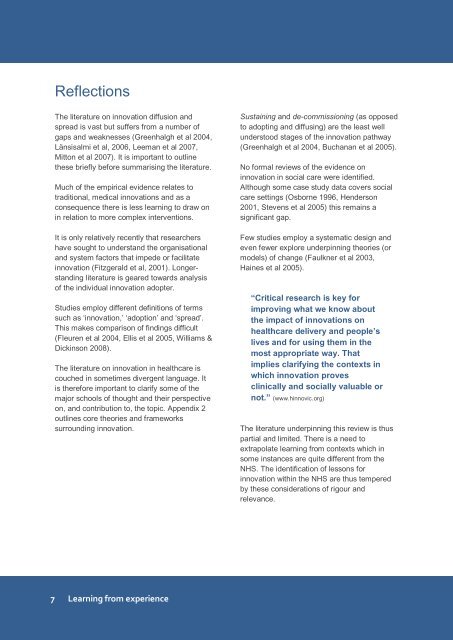Promoting and Embedding Innovation
Promoting and Embedding Innovation
Promoting and Embedding Innovation
Create successful ePaper yourself
Turn your PDF publications into a flip-book with our unique Google optimized e-Paper software.
Reflections<br />
The literature on innovation diffusion <strong>and</strong><br />
spread is vast but suffers from a number of<br />
gaps <strong>and</strong> weaknesses (Greenhalgh et al 2004,<br />
Länsisalmi et al, 2006, Leeman et al 2007,<br />
Mitton et al 2007). It is important to outline<br />
these briefly before summarising the literature.<br />
Much of the empirical evidence relates to<br />
traditional, medical innovations <strong>and</strong> as a<br />
consequence there is less learning to draw on<br />
in relation to more complex interventions.<br />
It is only relatively recently that researchers<br />
have sought to underst<strong>and</strong> the organisational<br />
<strong>and</strong> system factors that impede or facilitate<br />
innovation (Fitzgerald et al, 2001). Longerst<strong>and</strong>ing<br />
literature is geared towards analysis<br />
of the individual innovation adopter.<br />
Studies employ different definitions of terms<br />
such as „innovation,‟ „adoption‟ <strong>and</strong> „spread‟.<br />
This makes comparison of findings difficult<br />
(Fleuren et al 2004, Ellis et al 2005, Williams &<br />
Dickinson 2008).<br />
The literature on innovation in healthcare is<br />
couched in sometimes divergent language. It<br />
is therefore important to clarify some of the<br />
major schools of thought <strong>and</strong> their perspective<br />
on, <strong>and</strong> contribution to, the topic. Appendix 2<br />
outlines core theories <strong>and</strong> frameworks<br />
surrounding innovation.<br />
Sustaining <strong>and</strong> de-commissioning (as opposed<br />
to adopting <strong>and</strong> diffusing) are the least well<br />
understood stages of the innovation pathway<br />
(Greenhalgh et al 2004, Buchanan et al 2005).<br />
No formal reviews of the evidence on<br />
innovation in social care were identified.<br />
Although some case study data covers social<br />
care settings (Osborne 1996, Henderson<br />
2001, Stevens et al 2005) this remains a<br />
significant gap.<br />
Few studies employ a systematic design <strong>and</strong><br />
even fewer explore underpinning theories (or<br />
models) of change (Faulkner et al 2003,<br />
Haines et al 2005).<br />
“Critical research is key for<br />
improving what we know about<br />
the impact of innovations on<br />
healthcare delivery <strong>and</strong> people’s<br />
lives <strong>and</strong> for using them in the<br />
most appropriate way. That<br />
implies clarifying the contexts in<br />
which innovation proves<br />
clinically <strong>and</strong> socially valuable or<br />
not.” (www.hinnovic.org)<br />
The literature underpinning this review is thus<br />
partial <strong>and</strong> limited. There is a need to<br />
extrapolate learning from contexts which in<br />
some instances are quite different from the<br />
NHS. The identification of lessons for<br />
innovation within the NHS are thus tempered<br />
by these considerations of rigour <strong>and</strong><br />
relevance.<br />
7 Learning from experience
















